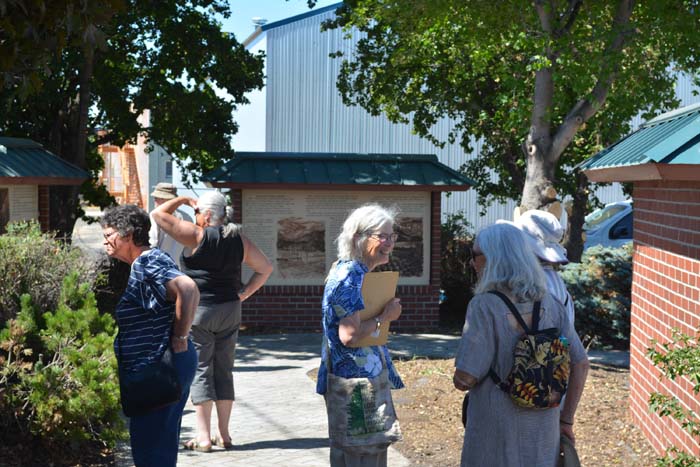Train Trek meeting highlights the need for potential new passenger rail services
Published 12:00 pm Thursday, July 27, 2023

- Susan Meis, center, of the Panhandle For Passenger Rail group, proudly tours the recently fixed-up passenger exhibit, cleaned of trash by the county and landscaped by P4PR.
Last week’s All Aboard Northwest organization’s Train Trek meeting was presented to nearly 50 gathered residents on July 22, in the bottom floor of the Carnegie Art Center.
“What is the largest set of railroads in the world?” Charles Hamilton, communications director at All Aboard Northwest, asked the group.
Guesses included China and India, but Hamilton was quick to clarify, “the United States has the largest, of anywhere in the world, so why aren’t we using it for passenger rail?”
“30% of the American population does not drive. Too young, too old, too poor, or disabled, like myself,” adding that it was why he didn’t stand for the presentation, “or they are in a place where there aren’t many options to drive, or are just concerned about the planet.”
“We want people to be able to get wherever they need to go,” he said, “People take trains because they have to, for a lot of people it’s the only option they have.”
“We’re talking about a return in investment,” he said, going on to describe the scale of impacts the trains have had. A main example coming from Virginia, where a 12 billion dollar interstate lanes expansion instead turned into a roughly 4 million dollar passenger rail service that ultimately reduced interstate traffic.
Hamilton described several cases of train services revitalizing areas, and prefaced his point with a map of the nation’s passenger train networks. Overlaid on the map, a Texas-sized oval of regions not served by passenger routes with the words ‘People Live Here…’ boldly stamped over it, which drew some laughter and conversation from the crowd.
Around a recently established train station in Meridian, Mississippi, Hamilton says “there has been over 200 million dollars invested in a 3 block radius.”
Though the original Pioneer route was closed due to its lack of ticket sales, Hamilton says the turnaround profits for rejoining passenger train services would be a major stimulus for local businesses, and that the Interstate’s potential tourists are simply driving past. A train schedule would almost preclude them into spending time and money in the city.
“Tourists (coming by rail) spend on average $86 per day, and if they stayed overnight spending as much as $366 dollars at shops, restaurants and hotels,” said Hamilton. “We’re talking about providing a square deal for everybody, big city, other side of the state, we want to provide a service.”
“Here’s how to help,” he said, “have more meetings like this. Convince decision makers. Complete projects. The more people hear about this that think this is a reality, the better. It’s not going to be overnight, but if you can get the kind of support that we need, folks in DC pay attention to that, if Baker City and communities around it want this, its people, who are really interested in making this happen.”
“With the Pioneer we have got a real opportunity, let’s at least get the money and get that working for us,” he said.
“Amtrak was speaking to us, but they need to hear your voice. There’s money on the table. This is about transportation,” said Hamilton, “you’re already paying for the highways, don’t you want some of that back?”
The All Aboard Northwest nonprofit says they’ll continue pushing for restored trains here and other locations within the large oval of non-service they’d provided, but says local groups such as Panhandle or Passenger Rail and Sumpter Valley Railroad Restoration will be crucial in keeping regional interests fresh as public options materialize.
Baker City Train Station hosts first tour since 1997
Preceding the event All Aboard Northwest nonprofit’s meeting, the Panhandle for Passenger Rail (P4PR) group out of Halfway lead a brief tour of the former Baker City Train Station, currently in the custody of the county, service as storage and offices for Union Pacific.
Rick and Susan Meis spent significant time preparing the building and the adjoining Railroad Square exhibit for public viewing.
The exhibit had recently been cleared of trash, after a community post on Facebook stirred public action. The county as well pruned back the trees and dealt with spurring weeds, meanwhile Rick and Susan Meis of P4PR did some replacement landscaping to the site for the touring group that evening.
“Baker rails were connected in 1884,” said Susan Meis, illustrating the original depot’s history before the tour, an original depot built in 1948, demolished in 1961, rebuilt in 1974, and then refurbished in 1997. Unfortunately, despite its completed refurbishment, the building was never used again as a passenger station, closing that same year due to the ending Amtrak Pioneer line.
“The depot’s owners (Baker County) have kept the station in ideal condition,” she said, “and it does not need any rehabilitation to bring it back to its former capacity. It’s got to be brought back.”
The P4PR group tour was attended by county commissioner Shane Alderson, who added that he wants some of the historic trains to also get some time to shine at the venue, and hopes the train services can subsidize medical and military ticket prices.





